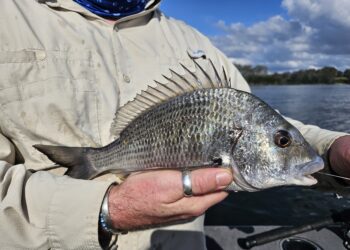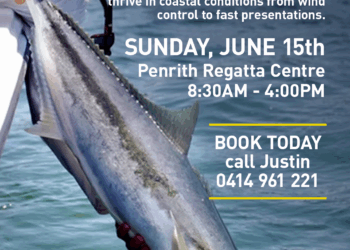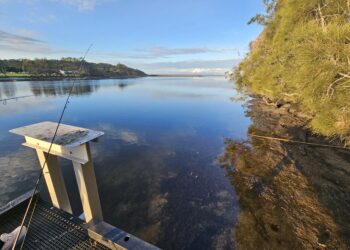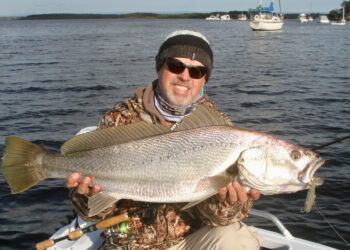SINCE I was a kid luderick have remained with me. I’ve held up my bat to acknowledge the half-century, and now in my 50s, the fish I catch (and now also release) more than any other is my purple-hued, stripey vegan buddy.
I say he’s vegan but that’s not entirely true. Every year in spring when the days here in Sydney start to reach the mid 20s again, I resume throwing lures around like an idiot, for more carnivorous targets. Yet still, as if he can’t get enough of me, my luderick pal appears and eats those, too.
That time of year also coincides with the emergence of young prawns, together with squirt worms who dance to the surface in the sandy shallows to propagate. The blackfish quickly fatten up on this high-protein diet, while also looking to propagate themselves.
Summer comes and the hungry, post-spawning luderick head up river to dine on blooming river algae in mangrove creeks and seagrass meadows. Autumn’s bigger swells see them play in wind-bashed headland washes, then in winter they are thankfully one of few species that stick around estuary mouths in the cold, clear water. They can be accessed at any time of year, one way or another.
Sydney sits right in the epicentre of their habitat span, though they do reach into southern Queensland and northern Victoria. In New Zealand they’re known as “parore” and are the same girella tricuspidata. Many kiwi locals refer to them as “sh*t-fish” perhaps without knowing how often they might actually be eating them as the “fush” in their “fush and chups”. To me it’s a little sacrilegious to put them down like that. I love the little buggers.

QUALITY AND QUANTITY
Winter 2022 had arrived with some discontent, but it took just one cold morning session on the blackfish to realise they were there waiting for me in number, as they always are. It’s been said that their numbers have been good even since the great depression in the early 1900s when broke folks desperate for food used rickety and sparsely-guided Rangoon-cane rods with freshy-gathered green weed or sea-cabbage, in order to catch plenty of blackfish to cheaply feed their hungry families.
That this can still happen today, when so many other species are so scarce can likely be attributed to the luderick lifestyle, where schools tend to congregate close to rocks and therefore where commercial nets can’t be safely laid.
Some might argue they taste weedy however any weedy taste is relative to how they are cared for. They must be kept cool, unstressed and have freshly oxygenated water while kept alive, then bled and all lining removed when cleaned. If they are then placed on ice or refrigerated to cool and firm, the fillets that come off are magnificent to eat and not at all weedy. If you buy them from a fish market where they are likely to have died some time ago without being immediately cleaned, then you could expect a strong taste from the fermentation of the weed within the gut.
For me personally, most are released nowadays. But then in my old age I get a real kick out of that, plus I’m lazy and it means there’s no work to do when I get home. With such small heads, they have a high ratio of edible muscle, being the bulk of their body, which means that any fish which are kept for eating will leave minimal waste.
We’re lucky that they use that muscle for good more than evil, like their drummer cousin does and with a soft rod, the angler can allow them to play out their energy with their pumps, flips, twists and tail-whacks until they subdue to the landing net.

BAITS AND BERLEY
There are a select few anglers who chase them with “fly” specifically, and those that fish with dual hooks – one baited and the second, a weed-imitation fly.
Fly fishing for luderick is deserved of a separate discussion entirely and to properly understand the presentation and overall deception, you’re best to have done the hard yards (although easier!) with bait first.
Green weed – there are many kinds but the darker string-weed found in tidal creeks and drains is number one. Similar versions can be found in freshwater or in ocean rock pools but are often weaker, slimy or coarse and not as readily accepted. When using weed, I like to only berley when the bite is slow. If fish are already on the chew, adding berley which can be taken away by current can actually send the fish away chasing it. Gathering a little extra bait and chopping up a handful, then mixing with fine river-sand is a simple way to get fish active if required. To bait up, a suitable amount of green weed strands are laid perpendicular across the line, above the eye of the hook. The line is then line pulled under the weed and over the hook and tightened to make a half-hitch on the centre of the weed strands, above the eye of the hook. One end of the weed strands is then wrapped down the hook one way and the other end wrapped down in the opposite rotation, leaving a teasing end below the hook.
Sea cabbage – best collected at low tide and in low swell. The darker clumps are preferred and need to be broken off, taking the roots with them. Push the hook through the tough root part, then once more through the fleshier part of the cabbage. Push the root area up past the eye until the cabbage lays flat. Make a loop and tighten the loop over the root area which becomes a half-hitch to hold it firm. Berleying on ocean rocks is as simple as a couple of kicks with your cleats, scraping the rock you’re standing on, sending little sprays of vegetation into the wash.

IN THE ESTUARY
Luderick are not scared to feed in high-traffic areas such as ferry wharves or rock walls where boat action makes regular waves which stir up the inter-tidal zone. In Sydney Harbour for instance, ferry wharves east of Birkenhead Point are all home to large luderick. They not only have the peace-disturbing ferries that berth there, but the constant noise and turbidity of large passing vessels, and yet they still fire.
Down here in the lower harbour, the fish can be huge too, with specimens over 45cm and exceeding 1.5 kg in weight not uncommon. They will take sea cabbage too in this heavily saline water, even though it’s inside the estuary.
In quieter sections of estuaries they equally enjoy pristine seagrass beds, where luderick are perhaps more common than any other angling target species.
Further upriver, they don’t mind the murk either! Muddy or more brackish water is well tolerated even at the uppermost tidal reaches where weirs step down from freshwater. In these cases, a selection of green weed found local to that area will always be best.
INSHORE WASHES
When fishing immediately inside the estuary, such as the inside of a breakwall or protected inshore area holding cunjie without facing the open sea, you may find these areas fire better when the swell outside is large and a refracted wave makes its way inside. This stirs the intertidal zone up with the unusual wave action and blackfish will come in from the heavy seas to these safer washes which still have that food availability. In the words of an old mate, that type of spot “fishes better when there’s a bit of a lump on”.
LUDS IN THE SUDS
It’s good to have a few rockfishing spots as other anglers will often reach your favourite position earlier, especially here in Sydney. Competition for the best standing positions can be brutal for those who miss out, if they over-sleep the pre-dawn walk-in.
While most ocean washes fish best toward the top of the run-in tide (also the time to be most careful of the rising sea), exceptions can be found by trying different spots at different depths. You can still find places that fish best at low tide, such as long drifts over deeper reef plains and fishing down to 15ft for instance. Schools often huddle over steep drop-offs only accessible at low tide and in caves or shadows beyond them.
Equally at the top of the tide you can fish “short” in 2-3ft of water where blackfish graze during that period.
In big seas they can move into backwaters and troughs under the cover of whitewater right at the top of the tide then retreat as soon as it turns.
Mr Reliable can be targeted one way or another in any swell and any tide stage, perhaps the only exception being low tide in a big sea.
RIGGING
Float stoppers are sold as simple yet amazing little devices that hold multiple float stoppers on a thin loop of wire. You thread your line through the end of the loop, then pull down the next rubber stopper off the wire, over the loop of line formed until it passes the tag end, then slide the stopper up the line. All well and good if your old-man eyes and crusty, numb fingers let you get the line through the skinny little wire loop.
From there, add a float suitable for the environment then a single sinker down to a small black swivel, with just enough weight to allow the minimum tip of the float to keep out of the water. It can take a few attempts but don’t settle for a float that sits up showing the bulb, as the blackfish will spit the bait out. Ensure it sits down in the water and add a split-shot as necessary. Small fluoro bobby-corks are great on the ocean rocks, allowing long casts and even when correctly weighted to sit down in the water, still have sufficient buoyancy to sit above the surge.
When fishing water that isn’t too rough two hooks can be used by adding a second leader to the swivel, making two traces. One leader can be short, 20cm and the other around 45cm. If one bait is stripped you’re still in business and have almost double the chance of a take, though it’s not recommended in kelpy areas as the second hook can snag-up during a fight. It’s also no good in fast current as the traces twist excessively.

HOOKING
Now for the fun parts. It’s difficult to put into words the combination of anticipation and anxiousness that come when that float or little bobby cork dips under the surface. After all these years I still find myself holding my breath and the world around me stops spinning momentarily.
Luderick can certainly be finnicky, tasting and turning the bait with their small mouths but hopefully, if the half-hitch holds, and the float weight is such that no resistance is felt, they will accept the bait and the float will be taken down away from view with a second, and more determined flourish.
This is when to pick up slack and ease into a taut line. If the hook point finds flesh, the fish will kick and the point will sink further past the barb while you continue to increase tension in a smooth and slow “strike”, and you’re in business. There is certainly an art to hooking them, whilst fighting the natural instinct to strike hard.
FIGHTING
Particularly if you feel it’s a large fish hooked, letting them do all their fighting out wide under a light pressure, they can bump away merrily for a while and expend energy they could otherwise use against you once in close. If they come in too “green” they will have too much control around the rocks at your feet. A fish still wild and energised, burying under rocks on a short leash with minimal stretch, can cause hook-pulls and bust-offs.
The larger specimens can be recognised shortly after hook-up by the long, slow thuds through the rod. Smaller fish will twist in a tight space which feels like more rapid bumps, while a larger fish has a longer, slower twist and head-shake, and can run a long way. Let them go wide and wear themselves out. A tired fish will better obey being led to a net, or up onto an ocean rock ledge.

LANDING
Inside the estuary or fishing inshore waters without swell, naturally a long-handled landing net (complimenting the long rod) makes landing easy. On the ocean rocks, you can’t keep a net on your person as you must be agile for escapes and general stability, so here it can be more complicated. It’s best to use a rising wave to lift an exhausted fish already on the surface, up and over a low, flat rock where they can be slid sideways without lifting, to a dry, safe place.
There the angler can pick the fish up with thumb behind the top of the head and fingers under the pectoral fins area, with the fish upright in a kind of comfort lift. If upright and supported they are usually calm while they regain composure. Then holding them against your side gives further stability for unhooking. Again all this is easier done with a tired fish, as is winding down and lifting them from higher ledges.
Luderick seem to be always accessible, one way or another depending on the state of the tide, size of the swell and the time of year. Along the NSW coast and beyond they are in good numbers and for those that keep them and look after them, they cook up terrifically. They have always been there for me. A reliable constant throughout my angling life. What more could you ask of such a friend.


















